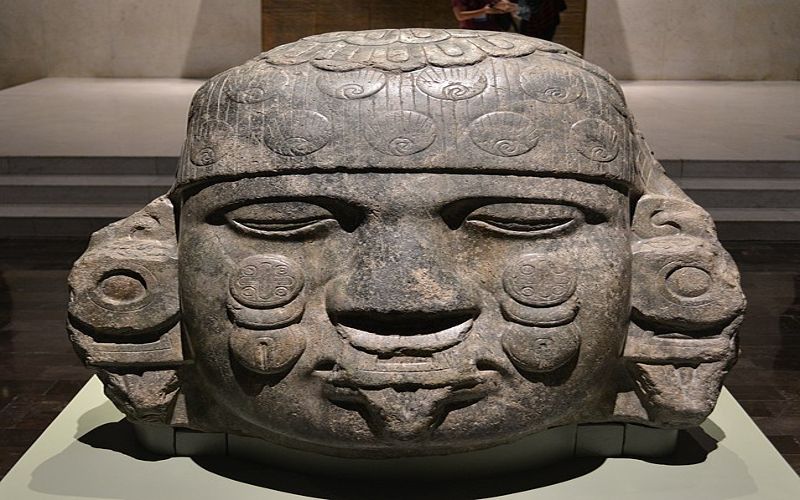Let’s be honest: family relationships are complicated and full of conflicts, even more so when the family grows. If you think your relationship with your parents or siblings couldn’t be any more toxic and complicated, an Aztec goddess named Coyolxāuhqui would like to have a word with you. Even among the Aztec goddesses her origins story stands out.
Such a toxic family relationship is certainly the most eye-catching detail of Coyolxāuhqui’s origin story, but there is so much more to this goddess. No one is defined by only one episode from their lives, and neither is this goddess.
Coyolxāuhqui’s Origin Story
As often happens with various deities, there are two different versions of Coyolxāuhqui’s origin story. Both versions carry strong and similar symbolism, so let’s learn more about each version.
The First Version
Coyolxāuhqui was the daughter of another powerful goddess, Cōātlīcue. She had 400 brothers, which were collectively called Centzon Huitznahua. Coyolxāuhqui ruled over the Milky Way, while her brothers ruled over the southern stars. Their mother was a goddess of fertility, life, death, and rebirth.
As if having 400 brothers wasn’t more than enough, Coyolxāuhqui found out that her mother became pregnant again. Infuriated, ashamed, and possibly jealous, Coyolxāuhqui decided to rebel against her mother and kill her and her unborn child.
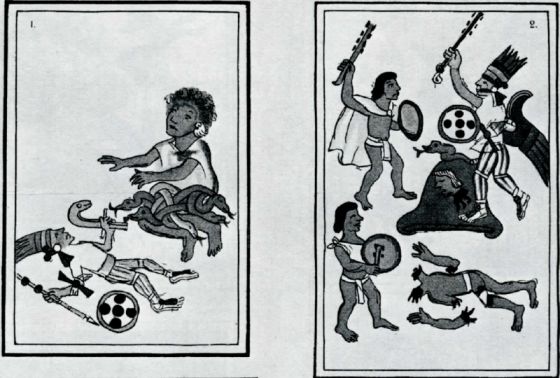
She managed to persuade her 400 brothers to plot against their mother. Soon enough, Coyolxāuhqui and her 400 siblings attacked Cōātlīcue, and in one variation of the story, they managed to kill her by decapitation.
However, the fight was far from over; as a matter of fact, it had just begun. From her womb, a powerful god Huitzilopochtli emerged. Although he was practically a newborn, he emerged fully grown and ready for the battle.
He started a counterattack, during which he managed to kill most of his siblings. Most notably, he decapitated Coyolxāuhqui as revenge for his mother’s death.
In another variation of this version, Coyolxāuhqui and her 400 brothers fail to harm Cōātlīcue at all. Huitzilopochtli was born just in time to defend his mother from his murderous siblings. Again, in this variation of the story, Huitzilopochtli killed Coyolxāuhqui and most of their siblings and became a powerful god of sun and war.
In both versions of the story, Huitzilopochtli decapitates Coyolxāuhqui and throws her head up in the sky, where it becomes a moon. Because of that, Coyolxāuhqui is also considered the goddess of the moon.
The Second Version
This version is less known than the first one, but it is just as interesting and significant. According to this version, Coyolxāuhqui wasn’t Huitzilopochtli’s sister. She was his mother, but that didn’t spare her from a gruesome death.
Things were going well up until one day when Huitzilopochtli decided that he and his mother should relocate to a new place of dwelling. However, Coyolxāuhqui was happy where they were, on the mountain Coatepec (‘Snake Mountain’).
That’s why she was reluctant to relocate, which, for some reason, infuriated her son Huitzilopochtli. In a fit of blind anger, he decapitated Coyolxāuhqui, ate her heart, and led Aztec people to new lands.
Our family issues sound so much more bearable now, don’t they?
Coyolxāuhqui’s Role In Aztec Religion
I gotta admit both versions of Coyolxāuhqui’s origin story are equally disturbing, but for Aztec people, they had a much deeper meaning that surpassed the motifs of domestic violence, murder, and sibling rivalry.
Huitzilopochtli murdering Coyolxāuhqui is a symbol of the relationship between the Sun and the Moon. For Sun to rise (or to be born), the Moon needs to set (to die). This is also a cycle of life and death. Without death, there wouldn’t be life, and vice versa.
From the point of religion, this story has another layer too. In many religions, one of the first and oldest deities was the goddesses of fertility. Later, human civilizations evolved and grew. Their goddesses of fertility were replaced by new deities, some of which ruled over the celestial bodies.
The story of Coyolxāuhqui killing her mother and then getting killed by her brother is a perfect allegory of this “trend” in the development of not only the Aztec religion but also many other world religions.
Also, Huitzilopochtli’s victory over Coyolxāuhqui has one more symbolic meaning. Many societies were established as matriarchal at first, but later on, the patriarchy took over. When Huitzilopochtli literally killed Coyolxāuhqui, the patriarchy figuratively killed the matriarchy.
Finally, Aztecs believed that Coyolxāuhqui’s fate served as a cautionary tale to all of her enemies or anyone else who dared to disrespect or attack their gods and goddesses.
The Emotional and Spiritual Symbolism of Coyolxāuhqui’s Story
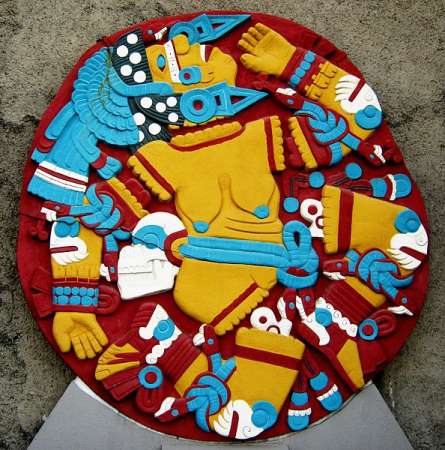
Sure, Coyolxāuhqui’s story has a deep and cultural meaning shared across many cultures. Still, the focus of this article is primarily on the spiritual symbolism of this goddess. Her story echoes in the lives of many women all around the world and across many time periods.
Mother Vs. Daughter
Mother-daughter relationships are one of the stronger bonds in human society, but they are also complex and sometimes even toxic. We don’t know much about Coyolxāuhqui’s relationship with her mother before the (attempted) murder, but it was certainly complicated.
If their relationship was healthy, why would Coyolxāuhqui plot to murder her mother? In some variations of the story, it is stated that Coyolxāuhqui wanted to murder her mother for dishonoring the family. However, such reasoning is much more prevalent among mortal men and male deities.
It is far more likely that Coyolxāuhqui wanted to step out of her mother’s shadow. She wanted to be the main character in her own story because she always felt like a side character in her mother’s story.
Religion and Fairytale Concepts of Motherless Daughters
This concept of being overshadowed by your parents is not only present in Aztec or other religions. For example, how many princesses from Disney movies or fairytales have living and present mothers?
The answer is very few. But why do these fairytales and movies kill off mothers (and fathers) so often, and usually early in the story? What was the actual reason behind Coyolxāuhqui’s attempt to murder her mother?
Killing off the mother, father, or another parental figure in one’s origin story is a mechanism that forces the child to grow up and assume the adult role of spouse, mother, and father. That seems a bit extreme, but many fairytale heroines would make completely different life choices if their mothers were around.
If that were the case, they would lead safer and more peaceful lives, but they would also miss the opportunity of enjoying adventures and finding their happily ever after. As cruel as it may sound, this reasoning contains a grain of truth.
Cutting The Umbilical Cord
This grain of truth is basically the main lesson that Coyolxāuhqui teaches us. Of course, this reasoning should be a valuable lesson only in a symbolic way. Under no circumstances should you resort to violence against your mother, any other family member, or anyone else.
However, as you grow up, you need to learn how to cut some strings that connect you to your mother, father, and family in general. Only then will you be able to live your life as a free, independent person that makes their own decisions.
When you get born, the umbilical cord that connects you to your mother is cut off. When you grow up, some other cords get cut off. Part of being a well-adjusted and successful adult is knowing which cords should be cut off and which ones should stay.
Coyolxāuhqui was probably too harsh in trying to cut the cords between her and her mother, and this harshness took her life.
Mommy Issues
Another aspect of Coyolxāuhqui’s relationship with her mother is definitely how healthy or toxic their relationship was before the murder attempt. As I said before, there are not many sources describing their prior relationship, but it is safe to assume that it was toxic.
Coyolxāuhqui obviously suffered from mommy issues, which she tried to resolve in a bad way. The mere fact that she felt like she had any right to decide whether her mother’s pregnancy was honorable points to the obvious lack of boundaries between them.
Mommy issues don’t receive the same level of attention as daddy issues. However, Coyolxāuhqui’s story shows us how dangerous mommy issues can be, especially when they aren’t resolved in a healthy manner.
In the second version of her story, in which Coyolxāuhqui is the mother and Huitzilopochtli is the son, we also have that motif aforementioned of cutting the umbilical cord. When Huitzilopochtli killed Coyolxāuhqui, he was finally able to move on to a new life.
Again, I cannot stress this enough, dealing with mommy/daddy issues should never involve an act of violence. However, finding a way to set healthy boundaries with your parents and other family members is the only way to live a free, independent, and fulfilling life.
Domestic Violence
Coyolxāuhqui’s story is also a story of the devastating effects of domestic violence. In one version, she tried to take her mother’s life, and it cost her her life. In another version, she was victimized by her son, and it was just as gruesome and horrific.
Violence should never be a way to achieve your goals. No matter how close we are to someone, we shouldn’t force them to live their lives how we consider to be appropriate.
In case we are the victim, we need to find a way to remove ourselves from such a toxic situation. Easier said than done, but if we don’t do it, it will only get worse.
Coyolxāuhqui’s Relationship to Other Goddesses
The most significant relationship between Coyolxāuhqui and another goddess is certainly the one with her mother, Cōātlīcue. After all, this relationship is the main point of whole Coyolxāuhqui’s story.
However, there are also other goddesses that are connected to Coyolxāuhqui in one way or another. As the goddess of the moon, Coyolxāuhqui is close to every Aztec goddess that is somehow connected to fertility, including her mother.
Some other Aztec goddesses that are also considered fertility deities are Xōchiquetzal, the goddess of love and fertility; Cihuacōātl, the goddess of childbirth, midwives, and fertility; and Toci, another goddess of midwives and childbirth.
All these goddesses can be considered as having some sort of relationship with Coyolxāuhqui since they are ruling over a similar domain, and that is fertility. As such, these goddesses are some sort of opposition to male, more aggressive, and war-like Aztec gods.
Moon and Fertility
You probably heard before that there is a correlation between the moon and fertility. But do you know what kind of correlation it is and why Coyolxāuhqui, as the goddess of the moon, is closely related to the goddesses of fertility?
This correlation stems from the fact that one cycle of the moon’s phases is approximately 28 days long, and that is also the average and most common length of the female menstrual cycle.
Another reason behind this correlation lies in the moon’s phases. From new to the full moon, this celestial body goes from being barely visible to being bright, shiny, and majestic. This is a great allegory for the cycle of life, death, and rebirth, which is again correlated to fertility.
Finally, the sun was always a symbol of masculine energy, and many gods that ruled over this celestial body were also the gods of war. Feminine energy is more suitable for a subtle, elegant, elusive, and mysterious moon.
Coyolxāuhqui’s Appearance and Depiction
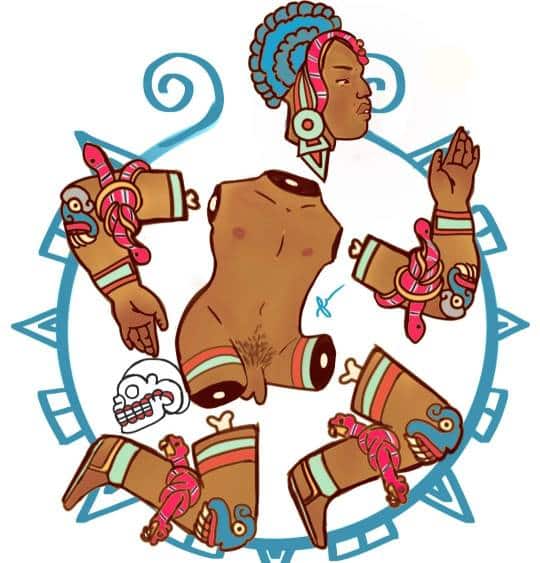
The rare surviving depictions of Coyolxāuhqui usually show her dismembered body and decapitated head. As the goddess of the moon and fertility, she was depicted wearing a belt of snakes with a serpent-like loincloth.
She also wore a feathered headdress with bells in her hair and a bell symbol on her cheek. Her snake belt also included a skull.
Coyolxāuhqui’s Stone
Probably the most famous Coyolxāuhqui depiction is on the great Coyolxāuhqui’s Stone. This stone is dated to 1473 CE during the reign of Axayacatl, and it was discovered at the base of the Templo Mayor, a pyramid shrine that was considered a twin shrine to Tlaloc, the god of rain, and Huitzilopochtli, a god of war.
This stone captures the moment after Huitzilopochtli killed Coyolxāuhqui, showing her dismembered body. Originally, it was full of colors yellow, blue, red, and white, but over time, the colors faded, and only the stone remained.
However, if you want to get closer to this goddess and you plan to travel to Mexico in the foreseeable future, you can find this relic in the Templo Mayor Museum, Mexico City.
Coyolxāuhqui And Her Christian Renditions
Finding a Christian version of the goddess that tried to kill her mother and unborn brother is not that easy, as you can imagine. However, as with most other Aztec and Mayan goddesses, Coyolxāuhqui was syncretized with the Virgin Mary or some of her variations.
Of course, to make her Christian-friendly, Coyolxāuhqui had to go through some sort of rebranding. Instead of wearing a feather headdress and bells in her hair, the Coyolxāuhqui’s headdress was replaced by a halo, which somewhat resembled a full moon. Her Serpent loincloth was replaced by more modest clothing.
Alternatively, due to her violent story and her depiction that might look scary to some, Coyolxāuhqui was sometimes seen as a symbol of sin, pagan worship, idolatry, and even as a demonic being.
Coyolxāuhqui-Like Goddesses From All Around The World
The concept of the moon-ruling goddess that was also closely related to fertility wasn’t unique to Aztecs. Many other religions had goddesses with similar duties as Coyolxāuhqui.
Some of the most famous names are Freyja, Isis, Hathor, Ishtar, Diana, Aphrodite, Parvati, and many others. All these goddesses had similar roles in their culture as deities of fertility, rebirth, and the moon. Of course, most of them didn’t have a disturbing origin story as Coyolxāuhqui.
Dos and Don’ts of Worshipping Coyolxāuhqui
There aren’t some strict dos and don’ts for paying honor to this goddess, but there are some things that are better than others for worshipping Coyolxāuhqui. For example, you can worship her by worshipping the moon, admiring its beauty and its strong impact on our planet and everything that inhabits it.
On the other hand, showing any form of disrespect or disregard for Coyolxāuhqui and her role in the universe is definitely one thing you should avoid. Even though she was defeated and killed by her brother, Coyolxāuhqui still remained a powerful deity and a cautionary tale to everyone who was disrespectful towards the gods.
Legacy
After learning so many things about this goddess, it is easy to see that she can teach us so many things, despite her own story being so messed up. As with everything else, we should look for good things and implement them into our lives while still being aware of all the bad things.
Even those bad things can be a good lesson, and Coyolxāuhqui and her story are perfect examples of that. Her story certainly delves into the complexity of mother-daughter and mother-son relationships. Most of us have loving and caring yet complex and sometimes frustrating relationships with our mothers.
Coyolxāuhqui teaches us that we need to work on those relationships and that we need to set clear boundaries while still maintaining an affectionate and deep connection to our mothers. Only then, will we be able to lead fulfilling, happy, and independent lives.
Also, Coyolxāuhqui teaches us another lesson that is very obvious, but let’s go over it one more time. Resorting to violence as a way to resolve some issues is never a good idea, and it can only cause us more problems and suffering.
Experiencing acts of violence, especially by our loved ones, is never acceptable, and it can quickly escalate and end in tragedy. This is why it is so important to remove ourselves from such situations when they happen, no matter how painful that process can be.
Finally, Coyolxāuhqui teaches us to get in touch with our feminine side. Like the moon, she impacts our fertility. She also impacts not only our monthly cycles but also our life cycles.
Symbols
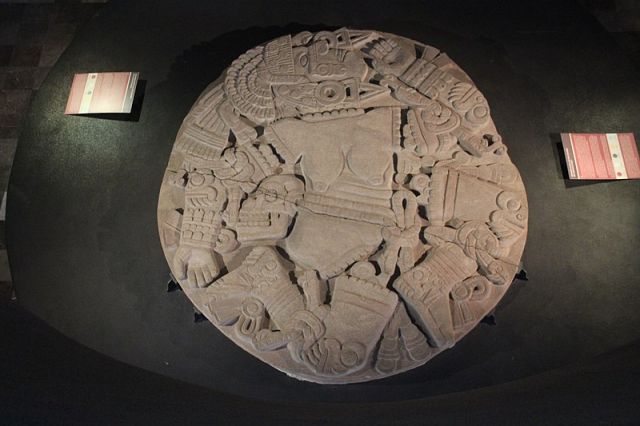
As a goddess of the Milky Way and the moon, Coyolxāuhqui is also related to fertility, life, death, and rebirth. There are many symbols that we can use to represent Coyolxāuhqui in relation to her story and domain of authority.
General
Of course, the main symbol of Coyolxāuhqui is the moon itself. The moon symbolizes Coyolxāuhqui’s decapitated head, but it also symbolizes fertility, cycles of life, and dark feminine energy.
Other symbols of Coyolxāuhqui are bones, skulls, feathers, bells, and eggs.
Animals
Since Coyolxāuhqui wore a skirt and belt made of serpents, it is safe to say that snakes are the best animal symbol for this goddess. Snakes represent fertility, rebirth, immortality, transformation, and healing.
Some other animals that could be good symbols for Coyolxāuhqui due to their connection to fertility are rabbits, cows, and bees.
Plants
There are many plants that symbolize fertility, and corn is certainly one of the best choices to symbolize Coyolxāuhqui. Some other great choices are orchids, marigolds, lotus flowers, and poppies.
Perfumes/Scents
Did you know that moondust smells like spent gunpowder? This scent is also quite appropriate to be a symbol of Coyolxāuhqui, as it is also reminiscing of this goddess’ destructive nature.
However, if you want to surround yourself with more pleasant smells that will remind you of Coyolxāuhqui, you can choose something like lotus scent, amber, sandalwood, and musk.
Gems and Metals
Silver is a precious metal that has been compared to the moon since the dawn of human civilization. Both moon and silver have that cold shine in them, especially when compared to the moon and gold.
Some other great choices to symbolize Coyolxāuhqui are moonstone, pearls, amethyst, labradorite, and lapis lazuli.
Goddess Jewelry
There are many reasons why you might want to keep a healing crystal or stone close to you. Getting closer to your goddess by wearing her color or crystal is a great one. That they also look great as jewelry only makes it so much better!
Here is a guide to crystal jewelry you hopefully will find helpful. In it is a list of 30+ crystals and links to some really great looking jewelry with that crystal or stone. Enjoy!
Colors
Yellow, blue, red, and white are definitely Coyolxāuhqui’s colors because these colors were originally on the artistic depictions of this goddess. In these depictions, red is the color of the background, but it is probably the symbol of all the bloodshed.
Yellow is the color of Coyolxāuhqui’s body, blue is the color of her garments, and white is the color of the bones surrounding her. Apart from these colors, silver/light grey are also good choices for Coyolxāuhqui’s symbols, as these are the colors of the moon.
Meditations
- Coyolxāuhqui, goddess of moon and fertility, make me fertile so that I can bear many children.
- Help me be a good daughter to my mother, and give me the patience to tolerate her flaws.
- Help me to acknowledge that my mother did the best she could.
- I am an independent person, and I don’t need the approval of my parents for everything I do.
- Help me forgive my mother and learn from her mistakes.
- Let the Moon light my way through life.
- Help me accept that my life, just like the moon, has its phases.
- I embrace the divine feminine within myself and honor the mother-daughter bond that connects us all.
- I will never allow someone’s Sun to overpower my Moon.
- Make me fertile not only through children but also through creativity and good deeds
Want To Bring More Coyolxāuhqui Qualities Into Your Life?
- Embrace your womanhood, enjoy feminine clothes and tasty and healthy foods, and take care of your health, especially of your reproductive organs.
- Follow the lunar phases and how they affect your body and mind. This will further help you to get in touch with your inner goddess, and Coyolxāuhqui will be there to help you.
- If it is safe where you live, take a late evening or a night walk. You will be able to enjoy the silence and the peace that comes with the night.
- Take some time every month to admire the moon, especially when it is full. You will be amazed by its mysterious and magical beauty.
- Wear silver jewelry and pearls. Both of these are timeless choices that will make your every outfit more refined and elegant while paying tribute to Coyolxāuhqui.
- If you have a strained relationship with your mother or other members of your family, consider getting a therapist that specializes in such issues. They will help you overcome years of resentment and teach you how to communicate better.
- If you are particularly adventurous and you like unusual pets, consider getting a pet snake. Contrary to popular belief, they are not such demanding pets. Of course, do your research before you make a decision.
- Get a moon tattoo. This tattoo motif is quite popular because it looks great, never goes out of fashion, and will always remind you of Coyolxāuhqui and the lessons she taught you.
- Visit Mexico, the museums and archeological sites that contain Coyolxāuhqui’s relics.
- Offer a sacrifice to this goddess, but not in a traditional manner. Instead of killing an animal, sacrifice something else: a possession or a habit.
Other Goddesses
We hope you enjoyed this post. If so, we are sure you will enjoy getting to know some of the other goddesses we also write about. You can find the complete list of goddesses sorted across regions and religions here
Featured Image Credit: Carlos yo, CC BY-SA 4.0, via Wikimedia Commons

